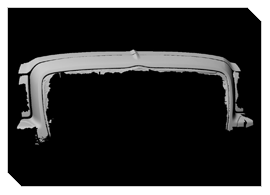

John Jenkins, President and CEO of Jenkz Innovation and Design Group, engaged Direct Dimensions for a unique 3D project. As a Chrysler 300 car owner, he had been interested in purchasing an aftermarket accessory to enhance the vehicle’s front grille. After an exhaustive search, he found that what he wanted did not exist on the market. So being an inventor and entrepreneur, Mr. Jenkins decided to patent and design the accessory himself.
That decision began a long process that led Mr. Jenkins to Direct Dimensions. He wanted to find a “one-stop shop” that could not only help him design the piece, but also assist with the complex manufacturing phases of the project. He was introduced to Direct Dimensions through an industry colleague. While Mr. Jenkins knew in his mind what he wanted his finished product to look like, he needed extremely accurate data of the car’s grille area to complete the design. He also needed assistance in getting a prototype created, and eventually engineers who could work closely with his production facility.
After consulting with the staff at Direct Dimensions about the project and understanding how Mr. Jenkins intended to actually fabricate the piece, the engineers opted to use a Faro Arm and Faro Laser Line Scanner to capture the data with an accuracy of +/-0.002”. Mr. Jenkins drove his Chrysler 300 to Direct Dimensions’ lab where it was scanned in just a few hours.
With the precise dimensions and complex contours of the Chrysler 300’s existing grill accurately captured, Mr. Jenkins outlined his concept design for the trim accessory so that it would fit perfectly with the other front trim pieces. Using Rapidform’s unique XOR software for design-intent reverse engineering, a digital model of what would eventually be called the Chrome Mustache™ was created to Mr. Jenkins' specifications.
Once the design team finished the CAD model, this data was transferred to our in-house replication services team to manage the rapid prototype process. Prototypes were then created using stereolithography (SLA), an additive process that uses a laser and liquid resin to layer plastic. SLA offers the advantages of very tight tolerances and also being good for master patterns for molding. A final prototype was then chrome-plated to approximate the anticipated finished product. Although only a prototype, it looked and functioned like a real production part.
Mr. Jenkins then used the prototype, 3D CAD file, and help from the engineers at Direct Dimensions to arrange for the creation of a plastic injection mold. When the production facility had questions or potential problems, the DDI engineers were able to collaborate with them to make minor design changes or answer questions, an example of a “one-stop shop.”
The “Chrome Mustache™” as it was named, was released to the consumer market in March 2008 and was so well received that the Jenkz Innovation and Design Group decided to create a second model for a slightly different version of the Chrysler 300. Direct Dimensions again collaborated with Mr. Jenkins to get his product to market successfully.
The Chrome Mustache™ is currently available for sale. You can find it at dealerships and distributors across the USA and Canada, or at its website: www.naked300.com